Femtosecond laser technology enhances corneal grafting
The smoother surfaces and the unique ‘brimmed hat’ shape produce a better and more stable fit of the graft with the patient’s cornea.
ROME – The IntraLase femtosecond laser can effectively be used to perform corneal transplantation, according to a team of Italian surgeons. The experiences of Elisabetta Böhm, MD, in Venice, Lucio Buratto, MD, in Milan, and Emilio Balestrazzi, MD, in Rome, were presented at the joint meeting of Ocular Surgery News and the Italian Society of Ophthalmology.
Results to this point, the surgeons said, are extremely encouraging. The use of IntraLase in what they called “IntraLase therapeutic keratoplasty” (ITK) adds accuracy and predictability to the procedure, gives more stability to the graft and promotes “a surprisingly fast visual recovery.”
“This laser allows us to fashion the corneal button in different shapes and sizes, according to the specific needs of the pathology we are dealing with. In Fuchs’ dystrophy or bullous keratopathy we can implant a graft that is larger in depth and smaller at the surface, to assure appropriate endothelial regeneration. Conversely, for keratoconus patients we can obtain a larger surface, to optimise refractive results and preserve the healthy endothelium of the recipient,” Dr. Böhm said.
The donor graft
Graft shaping and sizing, both in the donor and in the recipient corneas, is based on preoperative and intraoperative pachymetry.
Centration is crucial in cutting the donor button with the IntraLase, because “a 7- to 9-mm decentered graft would not be forgiving in terms of induced astigmatism,” Dr. Böhm said.
The laser performs the cut with a down-up motion, starting vertically at the endothelial level, and then moving horizontally within the stroma, and vertically again through the epithelium.
“The stromal step between endothelium and epithelium can be cut at different angles. We do it at 90°. The shape is like that of a brimmed hat, with the top on the surface if we want to treat endothelial deficiency syndromes, and reversed if we want a larger surface, like in keratoconus. Our standard measurements are 9 mm and 7 mm for the larger and smaller cut respectively,” Dr. Böhm said.
The graft is removed gently from the donor cornea with a hook or a small spatula.
“This is a delicate maneuver, because the donor cornea is usually very soft, still imbibed with water,” she said.
 | 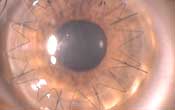 | 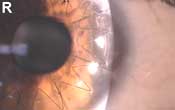 |
| Advanced keratoconus with leukomas and a thin corneal surface. The implantation of a graft with a larger anterior and smaller posterior diameter allowed an increase in corneal thickness in the thinnest areas, preventing the diastasis which may occur with the progressive loss of tissue elasticity in the long run. | ||
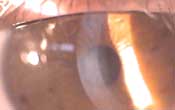 | 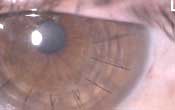 | 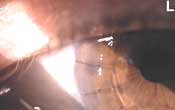 |
| Implantation of 7-mm anterior and 9-mm posterior corneal graft in Fuchs dystrophy. Images: Böhm E, Buratto L, Balestrazzi E | ||
Perfect adherence, stability
A similar procedure with the laser is performed in the patient’s cornea to prepare the recipient corneal bed.
Dr. Böhm said sutures should not be too tight, but deep enough to penetrate almost the full thickness of the flange (the ‘step’) of the donor graft. The sutures should be sufficiently tight to stretch the tissue and fit firmly in the corresponding space of the recipient bed. Fewer sutures are needed than in PKP.
“For better results, we apply single sutures to secure the deeper layer of the graft, and a continuous suture to level and smooth the surface. In myopic eyes, we do tighter sutures to stretch and flatten the graft slightly, while in hyperopic eyes we do a more loose suturing to increase corneal curvature,” Dr. Böhm said.
The suturing maneuvers required to make the donor button fit securely into the slot of the recipient cornea can be a difficult step in the procedure. However, even in case of an imperfect fit, once the sutures are removed the graft naturally tends to spread and adjust into the appropriate space.
The contact between the interfaces of the tissues is already assured and stabilized within the first week after surgery, and topography can be performed from the early postoperative days.
“The very smooth surfaces produced by the femtosecond laser allow for a perfect adherence between the donor graft and the recipient bed, which makes wound healing much faster than in traditional PKP. In addition, the shape of the cut, with the intermediate horizontal step between the endothelial and epithelial layers, creates a wide contact surface, which produces a better and more stable fitting of the graft into the patient’s cornea and a higher resistance of the eye to trauma,” Dr. Böhm explained.
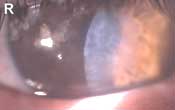 | 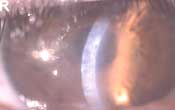 | 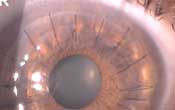 |
| Bullous keratopathy replaced with a 7-mm anterior and 9-mm posterior graft. The large base of this graft replaces 75% of the patient’s endothelium. The upper layers of the cornea, which do not need replacement, are partly preserved by the smaller diameter of the anterior cut. | ||
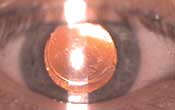 | 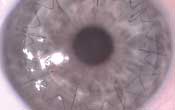 | 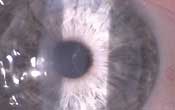 |
| Keratoconus in a pseudophakic patient previously operated with cataract surgery and IOL implantation. During the procedure there was no IOL displacement or other complications due to suction and applanation. A 9-mm anterior and 7-mm posterior diameter graft was implanted. | ||
Customizing the graft
With the IntraLase, buttons of slightly different size can be obtained from the donor and recipient corneas to achieve specific refractive targets.
In a young patient with keratoconus, a corneal curvature of 55 D and myopia of –20 D, a corneal button with an anterior diameter of 9.7 mm was removed and replaced with a graft of slightly smaller, 8.7-mm diameter.
“The 0.1-mm gap in the anterior surface allowed us to stretch the graft with the sutures and to have a flatter surface which effectively corrected the patient’s myopia,” Dr. Böhm said.
In another keratoconus patient with previous cataract surgery and IOL implantation, the procedure was also performed successfully without complication.
“We were afraid that the eye of this patient might not withstand the traction caused by suction and applanation; however, we had no problems during the procedure. The IOL remained firmly in place, and we implanted a graft with a diameter of 9-mm anterior and 7-mm posterior,” she said.
The possibility of implanting grafts with a larger anterior and smaller posterior diameter in keratoconus patients is particularly important in the advanced stages of the disease, Dr. Böhm said. Corneal thickness also can be increased in the thinnest areas of the keratoconic cornea, preventing the diastasis that may occur with the progressive loss of tissue elasticity long term.
In patients with Fuchs’ dystrophy or bullous keratopathy the reverse procedure is performed, with a 7-mm anterior and 9-mm posterior cut.
“With the large base of this graft we replace 75% of the patient’s epithelium, and implant a large quantity of new healthy cells. The upper layers of the cornea, which don’t need replacement, are partly preserved by the smaller diameter of the anterior cut,” Dr. Böhm said.
A traditional PK graft of 9 mm from top to base would be exposed to the risk of rejection because it would affect the integrity of the limbus.
The same team of surgeons is also using laser femtosecond technology to perform deep anterior lamellar keratoplasty (DALK) and deep posterior lamellar keratoplasty (DPLK).
For more information:
- Elisabetta Böhm, MD, can be reached at U.O. Oculistica Mestre, Venice, Italy; 39-041-260-7406/7407; fax: 39-041-260-7146; e-mail: elisabetta.bohm@tin.it.
- Lucio Buratto, MD, can be reached at Centro Ambrosiano di Microchirurgia Oculare, Piazza Repubblica 21, 20124 Milan, Italy; 39-02-6361191; fax: 39-02-6598875; e-mail: office@buratto.com.
- Emilio Balestrazzi, MD, can be reached at can be reached at Universita Cattolica del Sacro Cuore, Clinica Oculistica, Policlincio “A. Gemelli,” Largo Agostino Gemelli 8, 00168 Rome, Italy; 39-06-30156008; fax: 39-06-3051247 e-mail: emilio.balestrazzi@rm.unicatt.it.
- Michela Cimberle is an OSN Correspondent based in Treviso, Italy, who covers all aspects of ophthalmology. She focuses geographically on Europe.
